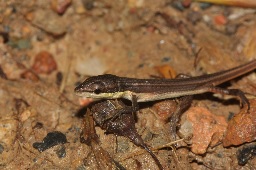Oriental Long Tailed Lizard (Takydromus sexlineatus)
Description: he long-tailed grass lizard is easily identifiable by a long tail, and has a white to cream coloured underbelly with a brown, green or beige back, often adorned with brown stripes of different shades. It typically has a small head with a sharply pointed snout and black or pink tongue. Its body is slightly elongated and thin with small pointy scales beneath the chin resembling a beard. Males have white spots on their sides, while females do not. Males have tails that thicken past the vent and are generally thicker than the female's down the entire length of the tail. The light stripes on the length of the body are yellower than the female's, which are more cream coloured. They grow up to 12 inches long, with the tail usually being three times their body length.
Habitat: This species is a grassland specialist. Its typical habitat is low grasslands, however it is also reported to inhabit areas of sparse vegetation in clearings, at the edge of forests, and in open plantations (Ziegler et al. 1999). It is well-adapted to disturbed areas with grassy roadsides, gardens, fields with shrubbery, and tall grass (Grismer 2011).
Range: Takydromus sexlineatus is found throughout South East Asia, and is native to a number of countries including India, China, Thailand, and Indonesia. The subspecies ocellatus is found in areas such as southern China, north Burma and north Malaysia.
Found in these States:
CA |
TX
Diet: Takydromus sexlineatus feeds on small insects such as flies, In captivity they can be reared on crickets and like other small lizards may require a calcium substitute. It is advisable in captivity to vary food including mealworms, sterile maggots or waxworms in addition to crickets. Unlike some larger reptiles, these lizards have extremely fast reactions and have been observed jumping into the air to catch flying prey such as flies.
Reproduction: It has been reported that females in southern Thailand laying 2-4 eggs; and reports of clutches of 2-3, hidden in soil or beneath grass roots.
Status: Takydromus sexlineatus is listed as Least Concern in view of its wide distribution and tolerance of a range of habitats, including modified environments. No major threats have been reported and this species is not thought to be undergoing a significant population decline.
»» Kingdom: Animalia - Animals
»» Phylum: Chordata - Chordates
»» Subphylum: Vertebrata - Vertebrates
»» Class: Reptilia - Reptiles
»» Order: Squamata - Lizards
»» Family: Lacertidae - Rock or Wall Lizards
»» Genus: Takydromus
»» Species: Takydromus sexlineatus - Oriental Long Tailed Lizard
This article uses material from the Wikipedia article "Takydromus sexlineatus", which is released under the Creative Commons Attribution-Share-Alike License 3.0. Content may have been omitted from the original, but no content has been changed or extended.
|








